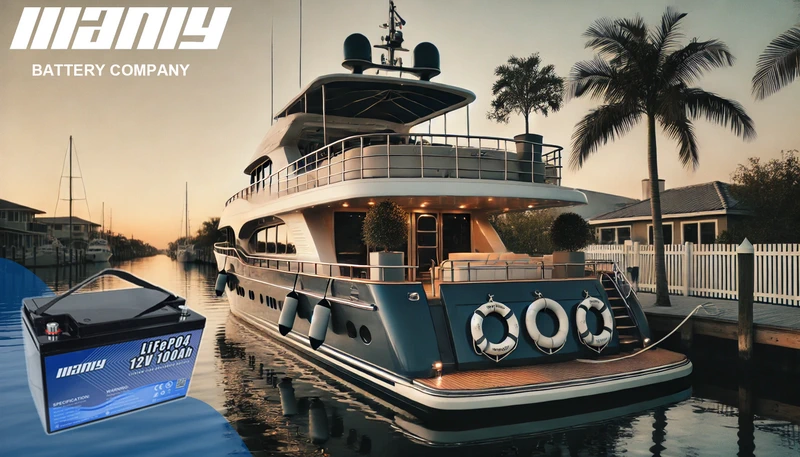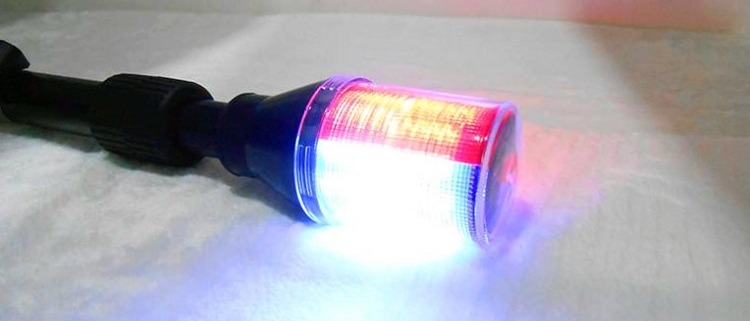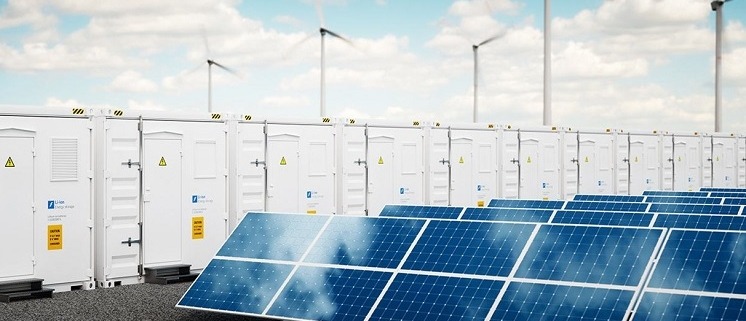What Type of Battery is a Marine Battery? A Detailed Breakdown
Table of Contents
- What Type of Battery is a Marine Battery? A Detailed Breakdown
- What is a Marine Battery?
- Different Types of Marine Batteries and Their Features
- The Best Choice: LiFePO4 Batteries for Marine Use
- Why LiFePO4 Batteries Are the Best Marine Batteries?
- Conclusion
- FAQ
- Hot Search
- Structural composition of solar panels
- The role of led warning lights
- Norwegian Equinor acquires 45% of Norker Power, a British battery energy storage developer
Maintaining a consistent and dependable boating experience depends on choosing the right marine battery. Whether you use a trolling motor, start your engine, or run electronics, the appropriate battery type will make all the difference. The several choices for batteries make many sailors find it difficult to choose the right one.
This article will break apart lead-acid, AGM, gel, and LiFePO4 batteries as well as other types of marine batteries. You will learn every type in great depth, including its benefits, drawbacks, and optimal uses. By the conclusion, you will understand the reason LiFePO4 batteries are the best fit for marine applications.
What is a Marine Battery?
Designed especially to withstand adverse sea conditions, a marine battery is Unlike automobile batteries, which only provide short bursts of electricity to start an engine, marine batteries must deliver constant power for lengthy durations while tolerating vibrations, dampness, and temperature variations.
- Usually driven by its intended use, marine batteries are categorized:
- The starting battery runs the boat motor. It gives a brief, sharp boost but lacks long-term vitality.
- Deep-cycle batteries run constantly for lights, fish finders, and trolling motors among other equipment.
- A dual-purpose battery sometimes performs worse than dedicated beginning and deep cycle batteries, even if it aims to combine two uses.
These classification indicate the use of a marine battery, although the most important factor influencing battery performance is battery chemistry. Chemistry of a battery determines its general performance, longevity, efficiency, and maintenance requirements.
Different Types of Marine Batteries and Their Features
The several kinds of marine batteries are listed below, together with their characteristics:
Lead-Acid Marine Batteries
Lead-acid batteries have been used in marine conditions as they have been rather competitively priced and widely available for decades. These batteries chemically react with lead plates and sulphuric acid to generate power.
Flooded Lead-Acid (FLA) Batteries
Flooded lead-acid batteries are the most classic form. They demand consistent maintenance, including topped off distilled water. They are heavy, require ventilation, have a shorter lifetime than other battery types even if they are economically priced.
Sealed Lead-Acid Batteries
Lead-acid batteries sealed eliminate maintenance needs and are spill-proof. Two most widely used variants that improve performance over typical flooded lead-acid batteries are AGM (absorbed glass mat) batteries and gel batteries.
Advantages of Lead-Acid Marine Batteries
Lead-acid batteries are reasonably cheap and rather numerous. Their great starting current makes them worth using for engine cranking.
Disadvantages of Lead-Acid Marine Batteries
Lead-acid batteries need regular maintenance, weigh a lot, and charge slowly. Usually running for two to four years, their lifetime is short; they break down upon discharge below 50% capacity.
AGM (Absorbed Glass Mat) Marine Batteries
AGM batteries are spill-proof and maintenance-free by absorbing the electrolyte using fiberglass mats, therefore improving traditional lead-acid designs.
How do AGM Batteries Work?
By immobilising the electrolyte inside the glass mat, AGM batteries reduce the possibility of leaking and hence maximise power efficiency. Since this structure lets for better resistance to vibrations and faster charging periods, AGM batteries are a more durable replacement for flooded lead-acid batteries.
Advantages of AGM Marine Batteries
Zero maintenance and faster charging than other lead-acid models describe AGM batteries. Their lifetime is between three and six years, and they have more resistance to deep discharges.
Disadvantages of AGM Marine Batteries
AGM batteries remain heavier than lithium alternatives even with their superior performance. On a tight budget, they also appeal less to boaters since they cost more than flooded lead-acid batteries.
Gel Marine Batteries
Gel batteries use liquid electrolytes from a silica-based gel. Less leaks and greater deep discharge performance are made possible by this chemical composition.
How do Gel Batteries Work?
The gel-based electrolyte lowers chemical reactions, therefore reducing the possibility of overcharging or deep discharge. Applications needing constant, long-term power will find ideal use for these batteries.
Advantages of Gel Marine Batteries
Gel batteries resist high temperatures, maintain a longer lifetime than flooded lead-acid batteries, and require no maintenance.
Disadvantages of Gel Marine Batteries
The slow charging rate of gel batteries is its biggest drawback. Furthermore expensive than AGM and flooded lead-acid batteries are they are. Less forgiving than other battery kinds, overcharging can damage a battery permanently.
The Best Choice: LiFePO4 Batteries for Marine Use
The most intelligent and powerful marine batteries are LiFePO4 (Lithium Iron Phosphate). Unlike lead-acid batteries, which rely on chemical interactions between lead and acid, they offer constant and dependable power by means of lithium-ion technology.
Why LiFePO4 Batteries are Superior?
Among their most important benefits are LiFePO4 batteries’ extended lifespan. Lead-acid batteries run two to six years; LiFePO4 batteries can run ten years or more. Since they weigh up to 70% less than lead-acid batteries and are more easily handled, they also greatly improve boat performance.
Charging time offers still another major advantage. Five times faster charging of LiFePO4 batteries than with lead-acid batteries Unlike lead-acid batteries, which have to be kept above 50% charge, they also enable total discharges free from battery damage.
Are There Any Drawbacks to LiFePO4 Batteries?
The sole negative of LiFePO4 batteries is their starting cost. For seasoned sailors, however, they are the most affordable choice because of their long lifetime, fast charge times, and low maintenance needs.
Why LiFePO4 Batteries Are the Best Marine Batteries?
LiFePO4 batteries have long-term benefits above all other battery models, even if their initial expense makes many sailors unwilling to switch. Boats carrying LiFePO4 batteries had 30% longer running lifetime on electronic systems and trolling motors, according a study by marine engineers.
Savings in weight also improve performance. LiFePO4 technology lets a boat greatly reduce the weight of its battery, therefore enhancing fuel economy and general maneuverability. Boaters looking for dependability, fast charging, and long-lasting performance would best invest in LiFePO4 batteries.
Conclusion
The perfect sailing voyage depends on selecting the right marine battery. Though lead-acid, AGM, and gel batteries are still somewhat popular, none give the efficiency, lifetime, and long-term savings LiFePO4 batteries offer.
LiFePO4 batteries from MANLY Battery provide the finest answer if you want a dependable and high-performance marine battery. Their innovative lithium technology guarantees exceptional energy economy, therefore assuring that your boat keeps running without the trouble of regular replacements.
For premium-quality marine batteries, visit MANLY Battery today and experience the next generation of marine power solutions.
FAQ
1. Is a deep cycle battery the same as a marine battery?
Let’s clarify: a deep cycle battery and a marine battery aren’t the same, although they have similarities. Here’s why:
A deep cycle battery provides a steady power flow over an extended period. It’s designed for applications that need consistent energy, like golf carts, RVs, or renewable energy systems. These batteries are built to handle repeated discharges and recharges without losing performance.
On the other hand, a marine battery is specifically made for boats. However, marine batteries come in two types: starting and deep cycle. A starting battery delivers a quick surge of power to start the engine, while a deep cycle marine battery powers your boat’s electronics and other devices.
So, while some marine batteries are deep cycle, not all deep cycle batteries work as marine batteries. If you’re choosing a battery for your boat, ensure it’s designed for marine use to get the most reliable power.
2. What are the three types of marine batteries?
Marine batteries come in three main types, each serving a different purpose. Understanding their roles helps you pick the right one for your boat:
- Starting Batteries: Starting batteries provide a quick burst of power to start your engine. They’re all about delivering a high-energy jolt for a short time. These batteries are not designed to power other devices, so they focus only on getting your engine running.
- Deep Cycle Batteries: Need power for your boat’s electronics, trolling motor, or other accessories? Deep cycle batteries are your answer. They deliver steady, long-lasting energy and can discharge and recharge multiple times without losing capacity. Perfect for extended trips or when you’re off the grid!
- Dual Purpose Batteries: As the name suggests, dual purpose batteries combine the functions of both starting and deep cycle batteries. They give you enough power to start your engine and supply energy to your accessories. They offer versatility but may not provide as much power as a dedicated starting or deep cycle battery.
Hot Search
Marine Lithium Battery Battery Manufacturer
Hello
Solar panel is a device that directly or indirectly converts solar radiation energy into electrical energy through photoelectric effect or photochemical effect by absorbing sunlight. The main material of most solar panels is “silicon”.
Structure and composition
1) Tempered glass
Its function is to protect the main body of power generation (such as cell), and the selection of light transmission is required:
1. The light transmittance must be high (generally above 91%);
2. Ultra-white tempered treatment
2) EVA
Used to bond and fix the tempered glass and the main body of power generation (such as cell). The quality of the transparent EVA material directly affects the life of the module. The EVA exposed to the air is easy to age and yellow, which affects the light transmittance of the module, thereby affecting In addition to the quality of EVA itself, the power generation quality of the module is also very affected by the lamination process of the module manufacturer. Component life.
3) Cells
The main function is to generate electricity. The mainstream in the main power generation market is crystalline silicon solar cells and thin-film solar cells, both of which have their own advantages and disadvantages.
Crystal silicon solar cells have relatively low equipment costs, but the consumption and cell costs are high, but the photoelectric conversion efficiency is also high, which is more suitable for power generation under outdoor sunlight; thin-film solar cells have relatively high equipment costs, but consume and battery The cost is very low, but the photoelectric conversion efficiency is more than half that of the crystalline silicon cell, but the low light effect is very good, and it can generate electricity under ordinary light, such as the solar cell on the calculator.
4) Backplane
Used for sealing, insulation, and waterproofing (usually TPT, TPE and other materials must be resistant to aging. Most component manufacturers have a 25-year warranty. Tempered glass and aluminum alloy are generally okay. The key is whether the backplane and silica gel can achieve Require.)
5) Aluminum alloy protective laminate
Play a certain sealing and supporting role
6) Junction box
It protects the entire power generation system and acts as a current transfer station. If the component is short-circuited, the junction box will automatically disconnect the short-circuit battery string to prevent the entire system from being burned. The most important thing in the junction box is the selection of diodes. Depending on the type of cell in the assembly, the corresponding diodes are also different.
7) Silica gel
Used to seal the junction between the component and the aluminum alloy frame, the component and the junction box. Some companies use double-sided tape and foam instead of silica gel. The domestic use of silica gel is simple, convenient and easy to operate, and the cost is very low.
Warning lights, as the name suggests, play the role of warning reminders. They are generally used to maintain road safety, effectively reduce the occurrence of traffic safety accidents, and prevent potential unsafe hazards. Under normal circumstances, warning lights are usually used in the development of police vehicles, engineering vehicles, fire trucks, emergency vehicles, prevention management vehicles, road maintenance vehicles, tractors, emergency A/S vehicles, and mechanical equipment.
Under normal circumstances, warning lights can provide products of various lengths according to vehicle types and uses, and have a structure of lampshade combination. When needed, the lampshade on one side can be combined with composite colors. In addition, warning lights can also be divided into light bulbs, LED flashes, and xenon tube strobes according to different light sources. Among them, the LED flashing form is an upgraded version of the bulb turning light, which has a longer service life and more energy-saving. Lower heat. What is the use of warning lights in these situations?
For example, for construction units, warning lights should be turned on during road construction, especially in the case of unknown road conditions at night, which can easily cause some accidents. Unfamiliar people can easily trip and cause traffic jams. , So it is very necessary and necessary to set up warning lights to play a warning role. Secondly, the same is true for cars driving on the road. It is very common that some problems occasionally occur during long-term driving. In the case of having to park on the road, in order to ensure safety, the driver needs to place a hazard warning on the vehicle in Fujian. Lights to remind passing vehicles to notice new obstacles ahead, slow down and drive safely. High-performance warning lights can expand the visual range of hazard warning models, allowing other driver groups to see this reminder more clearly. So try to use warning lights with good performance. In addition, when security guards are patrolling fixed security posts and police motorcycles, when criminals want to commit illegal incidents, they will be affected and prevent illegal actions. People who are injured can seek help in time, and a wider range of criminals will be affected. The role of warning and restraint can effectively control and reduce crimes and maintain social stability. LED strobe lights are installed in the community and on the sidewalks, so you can see it with more attention and protect yourself and your family better.
Of course, it is no exception for those who like to travel by bicycle. If you want to make it easier on the way, or if the tire is blown, you will have to stop the car. At this time, it is a very dangerous thing to park in a bend, and it is easy to cause a traffic accident. So this kind of more convenient LED warning light plays a key role. And not only is it a roadside warning, it can also be used as a lock when necessary.
Norwegian oil and gas giant Equinor recently announced that it has acquired a 45% stake in Norker Power, a UK utility-scale developer of energy storage systems and grid services.
In addition to acquiring the company’s equity, the two companies have reached an agreement on a strategic cooperation, which will give Equinor the opportunity to directly participate in the energy storage project being deployed by Norker Power.
Equinor said that it hopes to meet the increasing and stable demand of the electric power industry by deploying battery energy storage systems and to profit from it. In addition, the deployment of battery energy storage systems in the UK’s existing offshore wind power asset portfolio can increase returns.
Olav Kolbeinstveit, Senior Vice President of Electricity and Marketing of Equinor’s Renewable Energy Division, said: “Large battery energy storage systems can be charged when renewable energy is sufficient and discharged during peak power demand. This will enable companies to balance the market around , The need to stabilize the grid and improve supply security to build profitable services. The deployment of battery energy storage systems can enable the UK to make fuller use of renewable energy power.”
Noriker Power has developed and deployed battery energy storage systems with a total installed capacity of 250MW or more in the UK, and plans to deploy battery energy storage systems of 500MW or more, hybrid energy and stable grid service projects.
Noriker Power, headquartered in Gloucester, UK, will use Equinor’s investment to enhance its project development platform. These include engineering development, control system innovation and algorithm optimization.
Equinor will buy the shares currently held by Gresham House, a British asset management and investment group, and Gresham House Energy Storage Fund, which is listed on the London Stock Exchange. The two companies jointly own 15% of Norker Power’s shares. Gresham House initially acquired a 5% stake in the battery energy storage developer in August 2019.
Gresham House also acquired a ByersBrae battery energy storage project with an installed capacity of 30MW from Norker Power in April this year, with a total value of £15.6 million (US$20.6 million).







